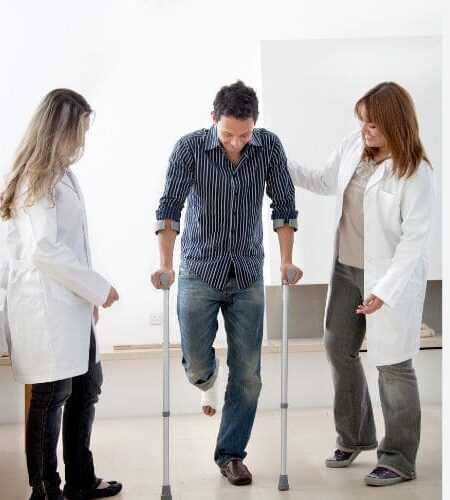When it comes to solo ambulation, choosing the right crutch is crucial for ensuring safety, stability, and comfort. In this comprehensive guide, we will explore the various types of crutches, factors to consider, and provide practical tips for safe ambulation.
Types of Crutches
Axillary Crutches
Axillary crutches are the most common type, extending from the ground to the armpit. They provide excellent support but may cause discomfort with prolonged use.
Forearm Crutches
Forearm crutches offer more mobility and are suitable for those with better upper body strength. They have a cuff that wraps around the forearm, providing a secure fit.
Platform Crutches
Platform crutches, featuring a forearm cuff and a horizontal platform for the hands, offer increased support. They are ideal for individuals with limited hand strength.
Factors to Consider
Height Consideration
Choosing the right crutch height is crucial for proper support. Improper height can lead to discomfort and may even cause additional injuries.
Weight Capacity
Ensure that the crutches can support your body weight. Manufacturers provide weight limits for each crutch type.
Mobility and Stability
Consider your mobility level and the stability provided by different crutch types. Some may offer more maneuverability, while others prioritize stability.
Choosing the Right Height
Proper Measurement Techniques
To determine the right crutch height, measure from the floor to the underarm, allowing a slight bend in the elbow. Adjust the crutch to match this height.
Adjusting Crutches for Comfort
Handgrip Adjustment
Adjust the handgrips to ensure a comfortable and natural grip. The handgrips should be at wrist level when the arms hang freely.
Elbow Flexion
Maintain a slight elbow flexion of about 20-30 degrees while using crutches. This position optimizes support and minimizes strain.
Tips for Safe Ambulation
Weight Distribution
Ensure even weight distribution between the crutches and your unaffected leg. This prevents overloading one side of your body.
Walking Surface
Choose flat and stable walking surfaces to minimize the risk of tripping or slipping. Avoid uneven terrain and obstacles.
Body Posture
Maintain an upright posture while walking with crutches. This reduces strain on your back and enhances overall stability.
Popular Crutch Brands
Ergobaum
Ergobaum crutches boast ergonomic design, shock absorption, and built-in safety features, making them an excellent choice for those prioritizing comfort and stability.
Millennial Medical In-Motion Pro Crutch
These crutches offer a spring-assisted design, reducing impact on wrists and shoulders. They are particularly suitable for individuals with an active lifestyle.
Mobilegs Ultra Crutches
Known for their innovative engineering, Mobilegs Ultra Crutches provide unparalleled comfort and flexibility, making them a top choice for solo ambulation.
FAQs
- Are forearm crutches better than axillary? Forearm crutches offer more mobility, making them suitable for those with better upper body strength.
- Can I use crutches if I have a knee injury? Crutches are often recommended for knee injuries to reduce weight-bearing on the affected leg.
- How do I choose the right crutch height? Measure from the floor to the underarm, allowing a slight bend in the elbow, and adjust the crutch accordingly.
- Are platform crutches suitable for everyone? Platform crutches are ideal for individuals with limited hand strength and offer increased support.
- Can crutches be used long-term? Long-term crutch use is possible, but it’s essential to consult with a healthcare professional for personalized advice.
- What are the alternatives to traditional crutches? Alternatives include knee scooters, hands-free crutches, and mobility aids like walkers or canes.
Conclusion
Choosing the right crutch for solo ambulation is a critical decision that impacts your safety and comfort. By considering factors like crutch type, height, and adjustment, you can confidently navigate your surroundings. Remember, the right crutch not only provides physical support but also empowers you on your journey to recovery.
